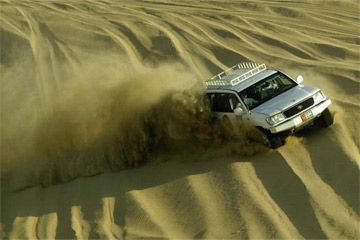For people who really want to get off the beaten path, off-roading is the ultimate driving adventure. Off-roading is used to describe driving on any unpaved surfaces -- which can include mud puddles, grassy fields, rocks, steep hills, sand dunes and more.
Although you could technically take any car off-road, not every vehicle is equipped to handle the many bumps and ditches associated with uneven ground. Off-road vehicles are designed to tackle rough driving conditions because they're equipped with four-wheel drive (4WD or 4x4). In a 4WD vehicle, the engine powers all four wheels, giving them greater traction. In vehicles with two-wheel drive (2WD), the engine powers only two wheels (usually the front wheels). 2WD vehicles aren't necessarily more dangerous off-road, but they may be harder to navigate over rugged terrain, which means you might wind up getting stuck [source: Burke].
Advertisement
Whether you take a 2WD or a 4WD off-roading, you want it to be well equipped. Adequate ground clearance (the distance between the bottom of the chassis and the ground when the car is on a flat surface) will help you get over rocks, hills and other uneven surfaces. A good suspension is also essential. "Most cars, you're going to get 2 to 3 inches of suspension movement, which is fine for speed bumps and corners, but not if you go into a deeper hole," explains Bill Burke, owner of 4-Wheeling America in Colorado. "When you're off-road, you need a suspension that will move up and down with the bumps and the holes."
Read on to learn why traction is important when you're off-roading, and the advantages of driving with 4WD.
Advertisement


